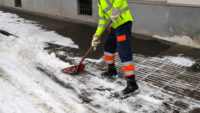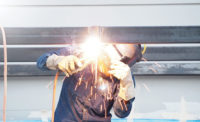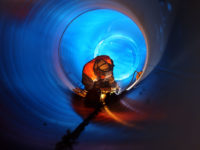Safety doesn’t stop just because it’s hot outside. As temperatures start to rise, it’s time to invest in summer-friendly workwear. Employers should emphasize comfort and safety when choosing equipment for their employees. Simply shedding layers doesn’t always work when it’s over 90 degrees Fahrenheit. Quality protection means meeting the needs of individual workers and choosing high-quality fabrics that won’t overheat workers on the job.
Heat stress and FR clothing
There’s a difference between keeping workers safe and keeping them comfortable in the field. Comfort is inherently subjective and difficult to measure, but employers should do their best to keep their teams comfortable on the job by choosing workwear that fits and maintaining the worker’s range of movement.
Heat stress is a preventable health condition that causes shortness of breath, fainting, headache, nausea, dizziness, weakness, profuse sweating, and even death in extreme situations. This can be caused by extreme temperatures, metabolic heat generated by hard physical work, or both.
The truth is that workwear rarely plays a factor in preventing heat stress. It doesn’t matter if the person is wearing a bulky garment or a lightweight fabric, preventing heat stress is more about giving workers frequent breaks, proper hydration, and keeping them out of direct sunlight. Some workers may have medical conditions that increase their risk of heat stress. Early intervention can prevent the worst of heat stroke. Workers and managers should do their best to watch out for red flags and symptoms and encourage team members to speak up if they are feeling unwell.
To prevent heat stress, employers should consider giving workers proper rest periods and water breaks to stay hydrated. Setting up some shade, installing a fan, or moving some of the team inside will always be more effective than swapping out workwear. Companies should also consider changing shift start and end times, so their workers don’t have to be outside during the hottest hours of the day.
Additional accessories can be used to further reduce the risk of heat stress, including cooling wipes and umbrellas. Workers should have access to sunscreen at all times. They can also carry individual packets of sunscreen on their person.
Instead of focusing on lightweight fabrics, employers should make sure their workers are healthy by doing their best to reduce the risk of sunburn and heat stroke ahead of time.
What to look for in summer FR workwear
There are many different factors to look for when choosing FR clothing, but “breathable” isn’t one of them. Employers should focus on the following when making their selections.
Fabric:
Some managers or employers may make the mistake of choosing breathable or lightweight fabrics to keep their workers cool, but these kinds of fabric aren’t flame resistant, so they won’t do workers much good on the job. Adding layers will only slow workers down, so it’s best to choose FR clothing that fits instead of flimsy fabrics that offer little protection.
Where appropriate, employers should invest in non-breathable garments, including chemical splash PPE, and other layers with impermeable barriers, such as multiple-layer garment systems, fire service bunker gear, high-calorie arc flash suits, and other bulky layered garments.
Fit:
It’s always best to have workwear that fits. Employers should do their best to find workwear that fits the unique shape and size of their workers. Different brands and styles tend to fit differently, so companies should avoid assuming their workers wear the same size when ordering from a different supplier.
A slight change in fit can make a world of difference for some individuals. It helps workers stay productive and safe on the job. Overly large clothing makes it difficult to move in the workplace, leading to slips and spills. Long sleeves and baggy pieces of fabric can easily get caught in equipment and machines. Overly tight clothing may cause workers to sweat in the field and limits their range of motion, which can put them at risk.
Shade:
Shade is an important factor when preventing heat stress. It’s always better to keep workers out of the sun whenever possible. Employers can use visors, hats, and neck shades to shield their workers from the sun.
When choosing FR clothing for hot weather, companies should always choose to cover their employees by offering long sleeves and pants. This may seem counterintuitive, but the fabric will protect the worker from the rays of the sun, reducing their chances of heat stroke and sunburn.
Again, it’s important to pay attention to the size and fit. The fabric should cover every inch of the person’s skin without getting in their way.
Brand/Style:
The quality of the workwear is also important. It’s best to use soft, moisture-wicking materials that help absorb perspiration. Employers should avoid knock-off brands or poorly made garments to keep their workers more comfortable in the field. Dry, itching fabrics can decrease productivity and increase irritability, especially when temperatures are high.
Companies should depend on reliable manufacturers in the safety workwear industry. Some brands have a reputation for optimizing worker performance without sacrificing safety.
Managers should address any concerns before asking their team to start their shift. Workers should also take a few moments to look over their clothing to make sure it’s still in good condition.
Comfort can be a fool’s errand when it comes to wearing FR gear in the summer. It’s never a good idea to sacrifice flame resistance or worker safety in favor of comfort or breathability. At the end of the day, some workers may not be comfortable working in extreme temperatures while wearing FR clothes, which is why it’s important to give them plenty of breaks and water.
The most employers can do is make sure the clothes fit properly, choose high-quality materials that keep workers safe and comfortable, and do their best to improve working conditions to reduce the risk of heat stroke. Keep these tips in mind when selecting summer-friendly FR gear for workers.



